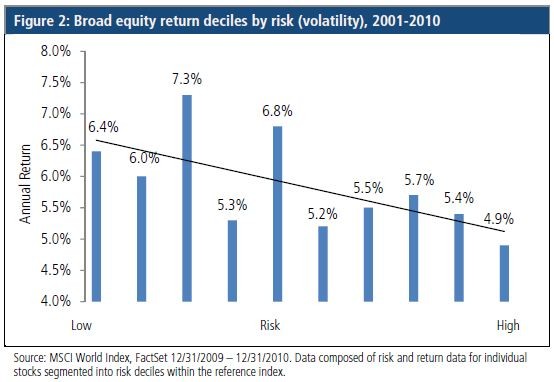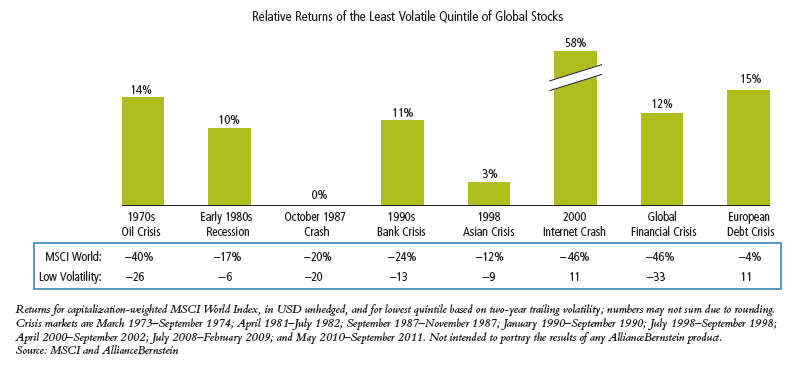Nardin Baker on the low volatility anomaly part two
Post on: 17 Апрель, 2015 No Comment

May 23, 2012
For some time now I have been intrigued by the research on the so-called low volatility anomaly. So much so that I devoted a section to it in my book Abnormal Returns: Winning Strategies from the Frontlines of the Investment Blogosphere . The low volatility anomaly research shows that in contrast to established academic research stocks with lower volatility (or beta) actually outperform higher volatility. The findings are even more striking when you look at them in some sort of risk-return context.
Since finishing the book more research has come out on the topic. A couple of weeks ago Nardin Baker of Guggenheim Partners Asset Management, LLC and Robert Haugen of Haugen Custom Financial Solutions and lowvolatilitystocks.com published a paper Low Risk Stocks Outperform Within All Observable Markets in the World at SSRN . The paper is accessible to non-academics and quants and provides some explanation on why these findings make sense in light of the agency issues with markets dominated by money managers.
Nardin Baker, co-author this paper, kindly agreed to answer some questions via e-mail about their paper and the practical implications of these findings for investors. The Q&A stands on its own, but I would recommend readers first check out Bakers paper and the first half our discussion. You can read the second half our discussion below:
Abnormal Returns: In the paper you note how agency issues are at the heart of why investment managers favor high volatility stocks. Knowing this how can investors offset this incentive for managers? Said another way what sort of investment process should investors insist that managers follow?
Nardin Baker: Investment managers behave in ways that maximize their compensation. Investors, therefore, can readily influence managers by altering the way performance is measured. By measuring the risk-adjusted alpha that managers generate and not just their return relative to the benchmark, investors can change the way managers behave. As we are taught in investment classes, the risk-adjusted return is call Jensen’s alpha, a measure that was introduced in 1968 to measure the performance of mutual fund managers.
As investors adopt risk-adjusted performance metrics, the managers, acting in their own interest, will modify their investment behavior and seek out high alpha stocks, ones with high return-to-risk ratios.
Abnormal Returns: In your paper you show the existence of a low volatility effect in every country studied. My intuition is that investing in low volatility portfolios should help in regards to diversification as well. Do you have any data on this?
Nardin Baker: Low volatility stocks can contribute to investment diversification by reducing risk and increasing return for an investor’s overall asset allocation. In the example below, allocations of stocks and bonds are combined to form allocations at 10% increments. Simple assumptions were made for expected returns, risk and the correlation between bonds and stocks was estimated over the last 20 years.

By adjusting the stock allocation to include 30% holdings in low volatility stocks, investors can improve the potential return and risk of their asset allocations. Greater low volatility allocations can offer improved opportunities.
Abnormal Returns: In the paper you point out the problem with using capitalization weighted indices. Every investment manager using cap weighted indices as a benchmark. What benchmark makes more sense?
Nardin Baker: Cap weighted benchmarks are not efficient in terms of risk and return, but they are still fair standards to be used for performance measurement. As noted above, risk-adjusted performance metrics solve the problem of correctly assessing a manager’s value added. If a portfolio has 80% of the risk of the benchmark, then the correct standard will be a benchmark that is adjusted to 80% of its performance. Symmetrically, a portfolio with 120% of the risk of the benchmark should be held to a standard that is 120% of the benchmark’s performance. Jensen’s alpha and the Sharpe ratio are two measures, well accepted and with long histories, that can be used to assess risk-adjusted performance.
Thanks again to Nardin for participating. We hope you enjoyed this extended look at the low volatility anomaly.














